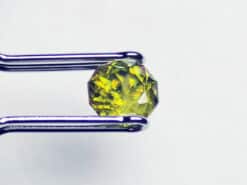Color change sphene

Green to red color change sphene or titanite.
Buy natural sphene in our shop
Color change sphene, or Titanite, is a calcium titanium nesosilicate mineral, CaTiSiO5. Trace impurities of iron and aluminium are typically present. Rare earth metals including cerium and yttrium are commonly present. Thorium replace partly calcium by thorium.
Sphene
Sphene, occurs as translucent to transparent, reddish brown, also gray, yellow, green, or red monoclinic crystals. These crystals are typically sphenoid in habit and are often twin. Possessing a subadamantine tending to slightly resinous luster, titanite has a hardness of 5.5 and a weak cleavage. Its specific gravity varies between 3.52 and 3.54.
Titanite’s refractive index is 1.885-1.990 to 1.915-2.050 with a strong birefringence of 0.105 to 0.135, biaxial positive, under the microscope this leads to a distinctive high relief which combined with the common yellow brown colour and also lozenge-shape cross-section makes the mineral easy to identify.
Transparent specimens are noted for their strong trichroism, the three colours presented being dependent on body colour. Owing to the quenching effect of iron, The stone exhibits no fluorescence under ultraviolet light.
Some titanite has been found to be metamict, in consequence of structural damage due to radioactive decomposition of the often significant thorium content. When viewed in thin section with a petrographic microscope, we can observe pleochorism in minerals surrounding a titanite crystal.
Sphene is a source of titanium dioxide, TiO2, used in pigments.
As a gemstone, titanite is usually some shade of chartreuse, but can be brown or black. Hue depends on Fe content, with low Fe content causing green and yellow colours, and high Fe content causing brown or black hues.
Zoning is typical in titanite. It is prized for its exceptional dispersive power, 0.051, B to G interval , which exceeds that of diamond. Spene jewelry is rare, The stone is uncommon in gem quality and relatively soft.
Color change
A good example of color change is sphene. These gems and stones appear very different in incandescent light compared to natural day light. This is largely due to the gems chemical composition as well as strong selective absorption.
Sphene appears green in daylight and appears red in incandescent light. Sapphire, also tourmaline, alexandrite and other stones can aslo show a color change.
Color change sphene video
Natural sphene for sale in our gem shop
We make custom made sphene jewelry as engagement rings, necklaces, stud earrings, bracelets, pendants… Please contact us for a quote.






